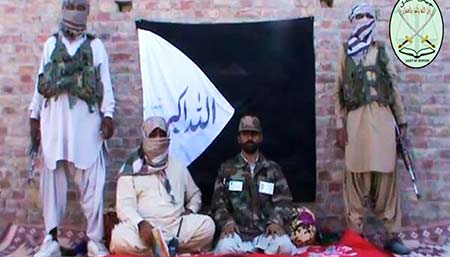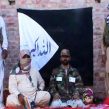
The Army of Justice and the Threat of Sunni Militancy in the Sistan-Baluchistan Province of Iran
Publication: Terrorism Monitor Volume: 11 Issue: 23
By:

Fourteen border guards in the southeastern Iranian region of Saravan were assassinated and five seriously wounded on October 25 by a shadowy militant Sunni group known as Jaysh al-Adl (JA – Army of Justice) (IRNA, October 25; Mehr News, October 25). In retaliation, Iranian authorities hung 16 Balochis (al-Akhbar, November 7). [1] A public prosecutor believed to have been involved in the execution of the Baluch insurgents was assassinated on November 6 and JA claimed responsibility, describing the killing at revenge against judicial authorities in a statement posted on the group’s website (al-Jazeera, November 7; Shafaf News [Tehran], November 12). [2]
Fourteen border guards in the southeastern Iranian region of Saravan were assassinated and five seriously wounded on October 25 by a shadowy militant Sunni group known as Jaysh al-Adl (JA – Army of Justice) (IRNA, October 25; Mehr News, October 25). Two weeks later, following the mass JA claimed responsibility for the assassination of a Zabol-based prosecutor believed to have been involved in the mass execution of Baluch insurgents as retaliation for the October 25 attack on the border guards (al-Jazeera, November 7; Shafaf News [Tehran], November 12).
The latest series of attacks by JA have not been isolated incidents. The armed Sunni group has carried out several military operations against the Iranian forces since 2012. The latest was on December 5, when four members of JA were killed by Iranian security guards in a series of skirmishes along the border between Iran and Pakistan (JamNews [Tehran], December 5). The militant group warns of future attacks against Iranian officials, while the Iranian state calls for a firmer response to such attacks.
JA describes itself as a “political-military” movement of the “Ahle Sunnat-e Iran” (Sunnis of Iran), with the aspiration of freeing the Baluch people from the hegemony of the Iranian government. The leader of the group, Abdul Rahimi Mullazadeh based in Sistan-Baluchistan (a.k.a. Salah al-din Farogi, not to be confused with an individual by the name of Mr. Shaykh Abdul Rahim Mollazadeh, a popular host to Satellite stations residing in London and also known as Abu Muntasir), comes from Rasak, a southeastern border town in the impoverished Sarbaz County whose local population has close cultural connections with the Pakistani region of Baluchistan (Shafaf, November 12; Iran Wire, October 28).
The movement maintains that it is a clandestine group that focuses on attacking military bases and deliberately avoids harming civilians in order to uphold a just war against the “Safavi” regime in Iran. The reference is to the Safavid Empire, which established Shia Islam as the state religion in sixteenth-century Iran.
The origin of the JA goes back to 2012, when the organization first emerged as an offshoot of Jundallah (Soldiers of God), a Sunni militant organization of Baluch ethnic background founded by Abdolmalek Rigi, who was executed by the Islamic Republic in 2010 (al-Arabiya, October 29; JameJam News, October 29; Shafaf, November 12). While Jundallah disintegrated with the death of Rigi, JA emerged as a new Baluch militant movement with strong sectarian ideological overtones. Unlike Jundallah, whose primary demand was that Tehran improve the lives of Iranian Sunnis, JA appears to be more of a separatist movement, demanding that the Iranian regime leave the Sistan-Baluchistan province.
In terms of organization, JA appears to be a tightly knit group of Sunni Baluch fighters who may have both rural and urban support in the Iranian and Pakistani border region. The group is based in three military camps near the Iranian-Pakistani border (JamNews December 2013). In operational terms, the group engages in activities such as the use of explosives against Iranian border guards, hostage-taking operations and assassination attacks against high-ranking government officials in the province.
The group has employed social media as a way to propagate its ideology and to express demands on the Iranian state. Videos and clips of military operations are posted online sporadically, often days or weeks after a military conflict between the organization and the Iranian military forces took place. JA leader Salah al-din Farogi and other commanders post anti-government statements on Facebook and YouTube, speaking of the oppressive nature of the Iranian regime and its efforts to marginalize Baluch, Arab and Kurdish populations. The videotaped confessions of prisoners purported to be Iranian intelligence officers are also posted on the group’s Facebook and blog sites.
According to the Iranian state, JA is a foreign-backed militia that is modeled after the militant-political organization Sazman-e Mojahedin-e Khalq-e Iran (People’s Mujahideen of Iran), a dissident-militant group known for its terrorist operations before and after the 1979 Islamic Revolution (Mashreq News, October 27). Tehran accuses JA of taking support from Israel and Wahhabi Saudi Arabia, which seek to destabilize the unity of Islamic Iran (ShiaNews, November 18).
In reality, JA is a political-military movement that reflects a recent wave of radicalization among the younger Baluch population. The trend towards militancy and sectarianism is largely due to a combination of domestic and regional grievances. Such grievances play an integral part in shaping the conditions upon which the JA has risen to challenge the Iranian state, though its success in legitimizing its operations among the local population remains unknown.
Sistan-Baluchistan is the most poverty-stricken region in Iran. The province has considerable infrastructural, educational and economic problems that are primarily caused by the unequal distribution of wealth. The decline of the Iranian economy, the fall of the national currency, the subsequent rise of inflation and increasing unemployment have contributed to growing poverty in the province.
Since the mid-2000s, the Islamic Republic has seen an upsurge in Sunni separatist militancy, partly in response to the economic conditions of the Sunni-majority province. Groups such as Harakat Ansar Iran (HAI) have increasingly adopted sectarian agendas in their militant operations against the Iranian state. Their anti-Shia outlook reflects the views of a Salafi militant movement that sees Shia Iran as responsible for the Muslim predicament, especially in Syria, where sectarian conflict has led to a bloody civil war and a proxy conflict between Iran and Saudi Arabia. [3]
Sistan-Baluchistan borders Afghanistan and Pakistan, two countries that also face instability due to drug-trafficking and secessionist insurgency movements. In February 2013, Iran signed a security agreement with Pakistan to prevent the flow of organized crime and militant forces into its territories (Press TV [Tehran], November 5). However, the borders remain porous, allowing a flow of insurgents and drug smugglers in and out of the country.
The insecure borderland has seen a sharp rise in sectarian tensions since the dawn of the Syrian civil war in 2011, possibly exacerbated by a Saudi Arabian push to spread radical Sunnism as a counter-balance to Iran’s involvement in Syria. JA has repeatedly described its “revenge operations” in terms of retaliating against Iranian military involvement in Syria. For the Sunni Iranian militant group, their conflict with the Iranian Revolutionary Guard and representatives of the Islamic Republic is one between “justice” and shirk (idolatry or polytheism), a major act of transgression in Islam that is often associated with Shiism by Sunni Salafists.
The regional dimension underlines the interplay between sectarianism and the regional proxy conflict between Iran and Saudi Arabia. The sectarian dimension in particular is the most problematic aspect of the security breakdown in southeastern Iran. The security crisis derives not only from the failure of the Iranian state to improve the life of the poverty-stricken province in terms of expanding economic projects to better the daily lives of the population, but also from the proliferation of separatist movements with sectarian agendas in neighboring countries such as Afghanistan and Pakistan. In the years to come, the border regions between these three countries could enter a new era of possible ethnic-sectarian conflict with global security implications.
Nima Adelkah is an independent analyst based in New York. His current research agenda includes the Middle East, military strategy and technology, and nuclear proliferation among other defense and security issues.
Notes
1. Casualty reports are inconsistent. The semi-official site, Fars News, stated that 17 guards were killed and four were taken hostage (Fars News, October 26).
2. See https://jaishuladl.blogspot.ca/2013/10/blog-post_26.html.
3. See the Arabic and Persian political statement by the group on Facebook: https://www.facebook.com/permalink.php?id=125416294205692&story_fbid=490457414368243.





